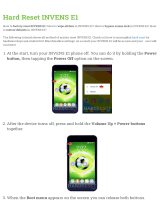
7
Technical Specifications
Display 9.7” touch screen 2048 × 1536
Processor
Octa-Core ARM Cortex A7, 1.7 GHz
(MT8392)
RAM 2GB
Internal Storage 16 GB *
Platform Android™ 4.4
Input/Output Ports
1×micro USB 2.0, 3.5 mm audio jack,
microphone, micro SIM card
Card reader microSD (SDXC/SDHC) up to 64GB
Communications
Wi-Fi (IEEE 802.11 a/b/g/n), 3G, GPS,
Bluetooth 4.0, FM radio
Camera
Rear — 8 Megapixels,
Front — 2 Megapixels
Audio Speaker, microphone
Accelerometer Yes
Battery Li-Polymer, 8000 mAh **
Dimensions 238.4 × 167.9 × 8 mm
Weight 520 g
Text Formats
epub, fb2, txt, doc, rtf, html, chm, tcr, pdf,
pml
Image Formats JPEG, PNG, BMP, GIF
Audio Formats MP3, WMA, AAC
Video Formats
MKV, AVI, MP4, FLV, WEBM, 3GP, MOV,
MPG, WMV, divX, Xvid, mpeg-4 SP,
mpeg-4, ASF, VC1, H264, H263, wmv 9,
MPEG-1, MPEG-2
* The actual available internal storage size may vary depending on the soft-
ware configuration of your device
** Battery life and values mentioned above might vary depending on usage
mode, connectivity and settings





















